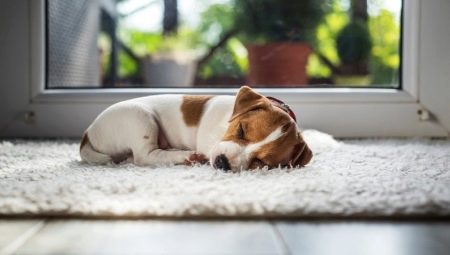The duration of a dog’s sleep depends on the individual characteristics of the animal’s body: body size, breed, age and the presence of chronic diseases. Puppies and older pets sleep longer than adults and young individuals. Let's see how many hours pets sleep and what it affects.
Dog Rest Duration
An adult dog should sleep 14-16 hours a day for a good rest in order to get rid of overstrain and stress. At this time, the hormonal background is stabilized, skeletal muscle relaxes, and the physical and psycho-emotional state is restored. A sleepy pet has a stronger immunity than an animal with insomnia.
The amount of time required for rest varies depending on the age and breed of the dog. Smaller animals require less sleep.
The more active the pet spent the day, the more time he will sleep.
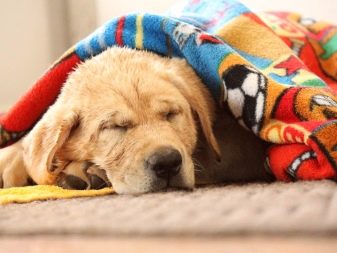
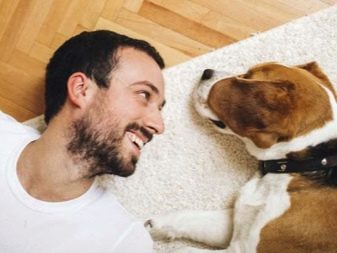
What does it depend on?
The main factor determining the duration of an animal’s sleep is its age. The duration of rest is also affected by:
- volume of physical activity;
- the presence of diseases;
- stress;
- body size and weight;
- Environment;
- daily regime.
Intensive training and various diseases lead to fatigue and shorten the time of rest. Stress and external stimuli interrupt deep sleep. Because of this, the dog does not get enough sleep, it becomes more irritable.
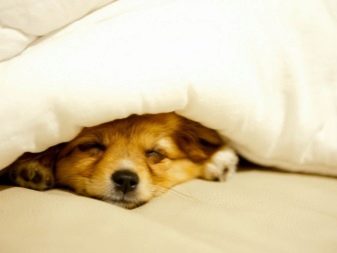

Age
Puppies need to sleep up to 20 hours a day to restore energy. Their body spends a large number of calories on the growth and development of the body.At the age of three months, animals do not respond to external stimuli, such as loud noise or bright light, so sleep in newborns does not interrupt. In this case, the dog should not be hungry. Due to its fast metabolism, a two-month-old puppy may feel hungry. Therefore, at the age of 1-2 months, dogs often wake up and whine, demanding food.
Starting from 4 months, the puppies begin adolescence. At this time, the development of all body systems is almost complete, therefore pets sleep up to 18 hours a day. At 4-5 months, their nervous system reacts more actively to external stimuli, so the puppy can wake up at night.
When a dog ages, having lived to 7-10 years, age-related changes in its body trigger the process of cell degeneration. Metabolism slows down, due to which the dog does not receive the right amount of energy. To compensate for energy costs, An older dog must sleep at least 20 hours a day. Moreover, in comparison with a puppy, his sleep is easily interrupted by external factors: smells, light noise, touches, light.
Older dogs prefer to doze off after daily walks or after eating.

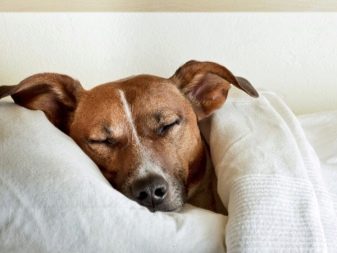
Breed
Dog breeds vary in size and body weight, therefore, each type of animal needs a different duration of sleep. Decorative pets with a small body - Yorkshire Terrier, lapdogs, Spitz - do not need a long rest. Their body is characterized by a high metabolic rate, which is why cells recover faster and begin to generate energy.
Dogs with a large body require up to 15-18 hours of rest. This is due to the fact that to maintain the work of skeletal muscles they need constant physical activity. Large breeds differ in temperament - due to their size, these dogs practically do not pay attention to external stimuli. As a result, their sleep lasts longer and does not interrupt.

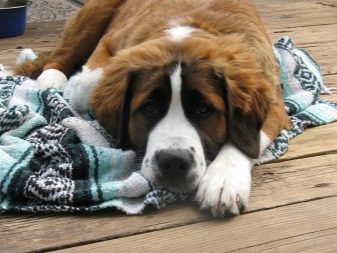
Health status
In the absence of chronic diseases, the dog should sleep from 14 to 16 hours a day, but if the pet does not get enough sleep at the age of 3 to 7 years, this indicates the development of a pathological process in his body. Usually, a number of diseases lead to a reduction in sleep time.
- Obesity. Accumulations of visceral fat compress the internal organs, leading to shortness of breath and poor tissue microcirculation. Adipose tissue has a negative effect on the circulatory system, because of which the brain does not receive the necessary amount of oxygen and nutrients. As a result, sleep hormone, or melatonin, stops being produced in the right amount, the metabolism slows down, which leads to sleep disturbance.
- Pathology of the cardiovascular system. Problems with the heart, blood vessels and pressure worsen the general condition of the body.
- Infectious diseases that provoke an increase in body temperature. In the acute period, hyperthermia interrupts sleep. The dog does not get enough sleep.
- Arthritis. Joint problems lead to pain that makes it harder for the dog to sleep. If in a dream the pet makes a sharp movement or takes the wrong position, the pain syndrome may intensify, and the dog will most likely wake up.
- Renal failure. The defeat of the urinary system disrupts the water-electrolyte balance in the body, which leads to a breakdown in metabolism and hormonal levels. As a result, the production of melatonin is reduced, which causes insomnia.
The fight against the disease takes a lot of energy, which leads to the development of stress. An exhausted pet begins to suffer from restless sleep. Lack of rest only increases stress and leads to a violation of the psychoemotional state. The dog becomes aggressive, irritable and naughty.
The development of the disease is reported by lethargy and loss of appetite. In such a situation, it is necessary to take the animal to the veterinarian, provide the pet with a comfortable and warm place to sleep.

Environment
The quality and duration of sleep is affected by the general atmosphere in the house. If the dog is not paid attention, she will begin to get bored. The pet will kill time with the help of sleep - usually the animal is constantly dormant throughout the day. As a result, the dog will not sleep at night. This behavior is normal only for weekly puppies whose eyes and ears do not open until 14 days of age. Newborns do not distinguish between time of day and require regular care.
In other cases, it is necessary to accustom the dog to night sleep, as well as pay attention to her physical activity. A tired pet will fall asleep faster and will not begin to annoy its owner with night activity.
During sleep, especially in 1 month of life, the dog should not wake up from external stimuli. The pet owner must learn to respect the rest of his dog, so do not turn on loud music or intentionally wake the animal. Restless sleep can disrupt the dog’s psyche and destroy friendships with humans.
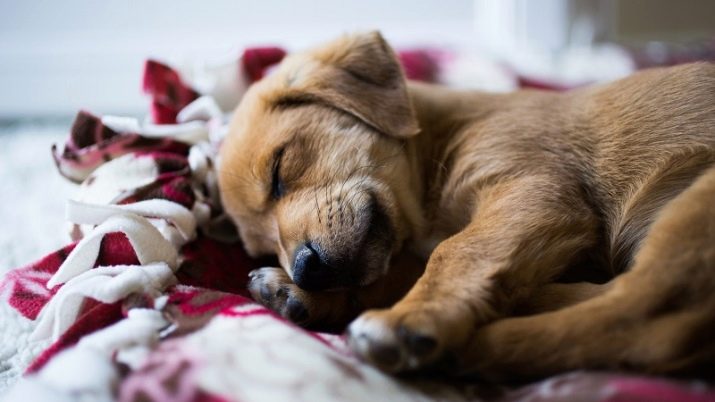
Mode
After a period of adaptation, the dog develops a daily schedule, thanks to which the animal regulates its sleep and wakefulness. For a good rest, starting from the age of 5 months, it is necessary to regularly subject the animal to physical activity. Atrophy of skeletal muscles occurs without games and proper activity. Against the background of physical inactivity, the dog begins to eat and sleep a lot, which can lead to obesity. Thanks to intensive training, you can adjust the amount of sleep and maintain the health of the pet.
In most cases, dogs focus on the owner. If a person likes to sleep after dinner, his pet will also not refuse to take a nap. Owners' habits are often adopted by companion dogs:
- Spitz
- pug;
- Bichon Frize;
- bolognese.
This behavior is not characteristic of hunting breeds such as a beagle or a retriever. They develop an individual daily regimen and do not tolerate disturbance of rest.
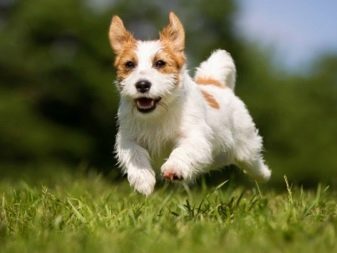
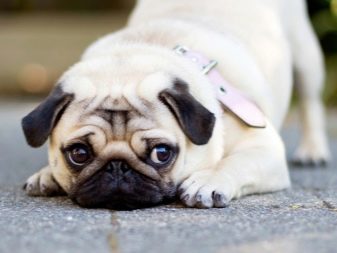
Phases
Sleep in dogs is divided into a number of periods, each of which performs a specific task.
- Nap. The animal relaxes the skeletal muscles, allowing the nervous system and sensory organs to relax. In this case, the dog remains conscious, controlling the state of the environment. Slumber is characterized as a temporary and intermittent rest, which can go into a full sleep.
- Shallow sleep. This period is a borderline transition from a nap to a deep phase of sleep. The dog continues to hear and see, retains a natural reaction to loud noise and light, but at the same time, the activity of its nervous system decreases. Metabolism begins to slow down, muscle tone decreases.
- Deep sleep. A complete rest for the musculoskeletal, nervous, endocrine and digestive systems of the animal. At this moment, the dog can dream and make some movements with its paws, face or mouth. The dog often makes sounds, whimpering or growling. This does not mean the appearance of a negative reaction directed at the host. The pet does not respond to external stimuli.
- Fast sleep. Only eyeballs move, which indicates the continuation of dreams. The muscles remain relaxed and motionless. Thanks to this phase of sleep, the dog restores psycho-emotional control, relieves stress. After a quick sleep before waking, the animal reverts to a state of shallow sleep.
The duration of each phase varies depending on the age and breed of the pet.

What do sleeping dog postures say?
The most comfortable pose is the position in the form of an embryo - the dog curls up. In this state, the grouped spinal and abdominal muscles protect the head and internal organs of the animal, which makes the dog feel safe. Some animals prefer to lie sideways, fully straightened and relaxed.
With the development of any disease, the dog remains constrained and goes to bed on his stomach. At the same time, the pet can clasp its head with its front paws.This situation indicates that the animal does not feel protected.
See what the posture in which the dog sleeps means in the next video.
